Loimugie: This l0 month old calf was first seen on the l0th February around the Wells that serve the pastoral community of Namunyak Conservancy but the Scouts were unable to catch up with him in order to bring him to safety
Loimugie: This l0 month old calf was first seen on the l0th February around the Wells that serve the pastoral community of Namunyak Conservancy but the Scouts were unable to catch up with him in order to bring him to safety. However, on the 12th he was found at Loimugi crossing near Serara Camp by a Scout named “Saningo” not far from the same Wells and this time followed the Scout back to the Serara base camp, desperate for water, and now much weakened. There he was held over night, and lovingly attended by “Saningo” throughout the night as well as fed 3 packets of rehydration salts.
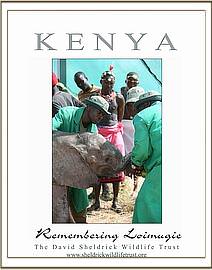
Meanwhile Ian Craig of the Northern Rangelands Trust contacted us in Nairobi, and the following morning the Rescue Plane was dispatched to collect him, Edwin Lusichi and Tal Manor aboard armed with the usual prophylactic injectible antibiotic plus milk and the camera to record his rescue. He arrived in the Nairobi Nursery at noon in a condition of extreme emaciation from milk deprivation, obviously having been without his elephant mother for some time. He was immediately very calm – far too calm for comfort, as though resigned to whatever befell him, which is never a good sign. He also had diarrheoa which is very life threatening.
The reason that has been orphaned is not absolutely known, but could be poaching, for there has been a marked escalation since the sale of the Southern African stockpiles and the advent of the Chinese. Evidence of this is seen by the amount of ivory on sale in Ethiopia, all of which apparently comes from either Kenya or Sudan. Since there are few elephants left in Sudan, it is likely to be Kenyan illegal ivory, poached due to the escalation in the price paid to the poacher since the Chinese construction workers became involved in road contracts in that part of Kenya. Several Chinese Nationals have been apprehended at Jomo Kenyatta Airport recently trying to smuggle out ivory, KWS using Sniffer Dogs to identify this contraband. Around the Amboseli ecosystem Chinese construction gangs working on the Namanga and Emali roads are known to be buying ivory, bushmeat and dogs.
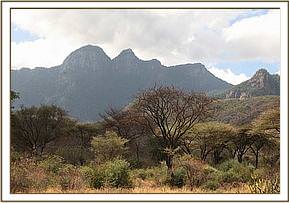
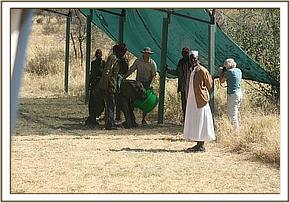
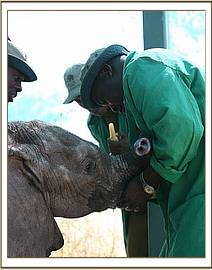
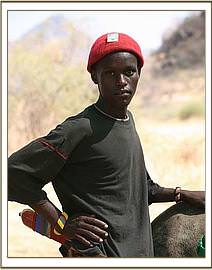

We called the latest little bull “Loimugi” after the place where he was found within Namunyak Conservancy in the North. The other Nursery elephants were brought to the next door stable to encourage him to want to try and live, and because the Manager of Serara Camp believes that perhaps Sabachi would know him, since both came from the same area. However, it was little Kenia who showed most compassion and care, for she is the Mini Minus Matriarch of the Nursery’s Junior Group, Lesanju, Lempaute and Sinya in charge of the older Nursery orphans.
The Namunyak Wildlife Conservancy is an area of approximately 76,000 hectares folded around the Southern end of the fabled Mathews Mountain range of hills in Northern Kenya, home to the proud semi nomadic pastoral Samburu people who have long coexisted with the wildlife of their land. The colourful image of a Samburu Warrior clad in traditional garb being reunited with the Ithumba Unit orphans, some of whom were rescued by the Namunyak community, graces the front of our 2008 Newsletter.

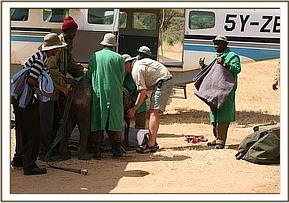

Despite all our efforts to try and get control of Loimugi’s diarrheoa, the few reserves he had rapidly disappeared, and by the 20th February he was in a coma, with what little life left in him sustained by a Dextrose drip directly into an ear vein. He died a few hours later.
The Rescue and Death of Orphan Muti
Valentine’s Day – the 14th February 2009, brought us yet another orphaned elephant, this time from the Masai Mara community near the small town of Kilgoris, the origin of a baby of that name whom, sadly, did not make it. This time the orphan was an 8 month old baby bull from a place called Mtingkwaware who was seen wandering on his own by the Masai community of the area who alerted the Kenya Wildlife Service to come and rescue him, anxious that the orphaned baby could be saved. Cpl. John Simka, and Rangers Samuel Okumu, Gladys Tanui, Ann Mathinji resonded, and managed to capture the calf, bind his legs and, take him to a holding boma not far from the Kichwa Tembo airfield. Once our keepers arrived they were taken to the boma, were able to feed the calf and prepare him for the flight back to Nairobi. This calf arrived just a day after little Loimugi from Namunyak Conservancy, leaving us even more shell-shocked and bringing the Nursery contingent to 19!
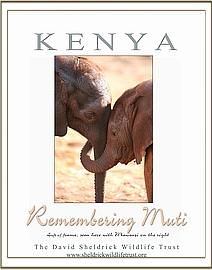
With elephant accommodation now stretched to the limit, adjustments had to be hurriedly made to the sleeping arrangements, especially when the calf actually arrived at dusk, and we were able to assess his size and age and were told that he was very feisty. Since it would be difficult to be able to calm him in the confines of a small stable without risking injury to a Keeper, Siria had to be hurriedly removed from his Stockade to double up again with Wasessa, so that the newcomer could occupy a larger area with an escape platform. He was given the usual prophylactic antibiotic and anti-muscular dystrophy jabs and taken to the Stockade, where his legs were un-tied. Keeper Abdi then set about calming him down, while Shimba and Mzima were interested on-lookers from next door. The new baby bull spotted them, and tried to vent his anger on them as well, repeatedly charging the separating poles, while Shimba and Mzima looked rather confused! However, the little bull, whom we named “Muti” was emaciated, but still quite strong, and took milk and rehydrants throughout the night. However, one hind leg looked mis-shapen, possibly from an old break which has healed, and the other obviously bruised and painful from being tightly tied with sisal string for the car and plane journey.
We applaud the Masai community around Kilgoris, whose concern saved this young elephant and thank Ann Kent-Taylor’s team, Brian Heath and the Kenya Wildlife Rangers for bringing him to safety. A great deal of community work has sensitized many tribal communities to the value of their wild life, and what a precious and unique heritage it actually is. For the first time, many communities now go out of their way to rescue orphaned baby elephants, whereas in the past they would not have taken the trouble.
Elephant Muti was out and about with the other younger Nursery inmates after just one full day in the Stockades, during which time he slept, and slept, and slept, which was somewhat unusual. He made in the short time he was alive a very touching bond with Mawenzi who absolutely adored him, and would trail him everywhere and suck on his ear lovingly. We were cautiously hopeful that he would survive, but it was not to be. He suddenly collapsed without warning during the early hours of the morning of Saturday 21st February and this was so unexpected, for he had taken his midnight milk feed as usual, that the Keepers thought he was merely over-tired and needing more sleep. But when he was too weak to get up for his 6 a.m. milk feed, they knew that things were very worrying.
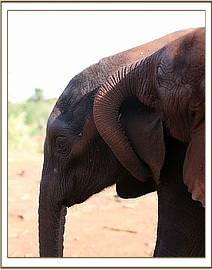
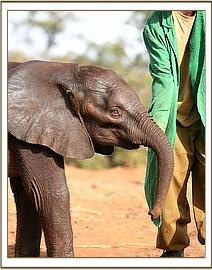

It has been our experience over the years that young elephants who share watering places with domestic livestock are very vulnerable to the Klepsiella spores found in cow-dung dust that can attack either the lungs, the liver, the spleen and other major organs, with rapid and very lethal consequences, resulting in death. In the case of Muti, this was in spite of having undergone 5 days of the prophylactic injectible antibiotic upon arrival to try and counter the affects of what is always a depressed immune system through the stress of losing the elephant mother and family, plus the added trauma of rescue.
In the case of Muti, it was the lungs that were affected. Suddenly fluid running from the trunk, and laboured breathing warned us that there was little hope of trying to save this calf and although a drip was hurriedly inserted into an ear vein to try and sustain him, he died just a few hours later – a day after we had lost little Loimugi.
The Rescue and Death of Baby Milgis
Three elephant rescues in just 3 consecutive days left us pretty shaken, bringing the total number currently in our Nairobi Nursery to 19. 2009 is turning out to be an “annus horribilis” for elephants in Kenya, and in fact, in all range States North of the Zambezi. Dryer than normal conditions possibly due to climate change, displaced people resulting from the political mayhem that gripped the country last year, exacerbated by lay-offs due to the downturn in the global economy, and lastly but by no means least, the presence of Chinese construction workers has resulted in a massive increase in poaching for Ivory, rhino horn, and bushmeat not to mention a decrease in domestic dogs as well!
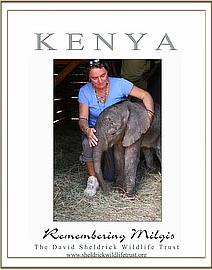
The evening of the 14th February brought another rescue alert from the Milgil Trust. Apparently, while trying to trace 2 other lone elephant calves in the area, the Scouts came across a newborn baby that had fallen into an erosion gulley near the Keno community area. The next morning Helen Du Fresne of the Milgis Trust flew the newborn baby to Nairobi in her small Cessna 182 aircraft. The calf stood quietly between two Scouts in the back of her plane. As she approached Nairobi’s Wilson Airport Helen requested for priority because she was flying with an elephant in the back of her small plane. The Air Traffic Control immediately cleared the skies, rather shocked by this extremely unusual request! On landing numerous people from all over Wilson poured out of their buildings to view the tiny baby. The elephant then followed his rescuers through the Customs building, delighting all on-lookers and arrived in the Nursery in fine fettle just after noon.
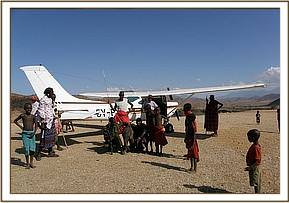



Yet again, great credit must be given to the Milgis Trust and the sensitization work they have done amongst that community of Samburu pastoral tribesmen, the rescuers of Lesanju, the mini Matriarch of the Nursery elephants. The brother of the late Chief Lesanju, after whom our orphan is named, was one of the two Scouts that brought little “Milgis” to the Nursery. She was newborn, soft, pink and trusting and we prayed that she had managed to take her mother’s first Colostrum milk which gives a baby the vital immunity to cope with life out of the womb and which can only be absorbed during the first 48 hours of life.
Sadly, however, quite obviously she hadn’t, for very soon diarrheoa set in, along with laboured breathing and a wet trunk, indicating pneumonia. We were left now with just one option, apart from the usual measures taken to try and contain the loose stools. We needed the plasma taken from a healthy elephant, and needed it urgently.
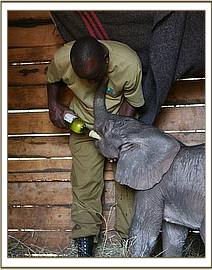

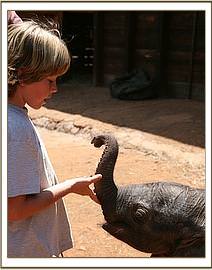
Anaesthetizing a healthy Nursery elephant, in order to try and save one which may not make it, is always a very tough dilemma, because the anaesthetic brings with it the factor of risk to a healthy donor. With this is the knowledge that unless one does this, the colostrums deficient baby will most certainly die. We chose Sinya as the donor because she had come in older than the other Nursery inmates, and was not among the four set to be moved to Voi the very next day, namely Wasessa, Shimba, Mzima and Siria, who would have to face not only a grueling journey on horrendous diversions in order to reach their destination, but would then have to adjust to a new life during the hottest time of the year in Tsavo. Sinya emerged none the worse for the ordeal, and that was an enormous relief for us all.
We now had a 24 hour wait for the separation of the plasma from Sinya’s blood, which was spinned at Karen Hospital. Meanwhile we kept baby Milgis alive on a Dextrose drip, and were cautiously optimistic when her stool seemed to be stabilizing, followed by the disappointment of the flood gates opening again, draining all her reserves. However, her little heart was still beating when the plasma arrived and was infused into an ear vein during the morning of Saturday 21st February. We all held our breath and prayed for a miracle, at the same time hardly believing that baby Milgis in her weakened state might survive the night. However, she did, and again we were cautiously optimistic that a miracle would take place, but sadly she died that evening, the same day that we lost Muti, and the day after losing Loimugi!



Never before have we had to bury 3 elephant orphans in just 3 days, and at the same time bid farewell to 4 others bound for the Voi Unit’s Rehabilitation Centre. February 2009 has been a month we shall never forget, nor choose to remember worth anything other than tears!